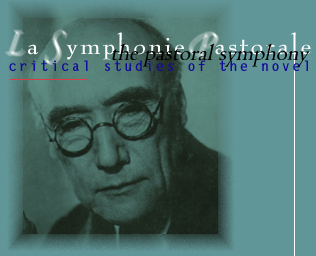

excerpt from pp.221-225
Portrait of Andre Gide: A Critical Biography, Justin O'Brien
Secker & Warburg, London, 1953



As in the other narrative works, Andre Gide has put himself into the Pastor with his lamentably good intentions, his sanctimonious hiding behind the Scriptures, and his blind self-deception. Thanks to his strict Calvinist background, Gide was most familiar with the moral climate that he evokes here. And all his life he had had a passion for teaching--like the Pastor who admits in an unguarded moment that he had promised himself great pleasure from educating his blind charge. Furthermore, Gide had spent the winter of 1894 in the icy Jura Mountains at inhospitable La Brevine, the scene he chose for his narrative.
Frequently the author has revealed the intention behind La Symphonie Pastorale. At the same time that he referred to La Porte etroite as the "criticism of a certain mystical tendency," he called the later fiction the criticism of "a form of lying to oneself." Later, adapting his terms to the Catholic priest to whom he was writing, he spoke of it as criticizing the dangers of "the free interpretation of the Scriptures." But the most revealing comment is found in a note on the Pastor inserted into a letter to an American scholar: "Through him, rather than trying to express my own thought, I have depicted the pitfall to which my own doctrine might lead, when that ethic is not rigorously checked by a critical spirit constantly on the alert and little inclined to self-indulgence. The indispensable critical spirit is completely lacking in the Pastor."
The Pastor's reading of the Scriptures corresponds exactly with that of Numquid. Capital passages of the little tale he narrates seem direct transpositions of the then unpublished spiritual meditation. Refusing to teach blind Gertrude the Epistles of Saint Paul, he raises her on the Gospels, in which he fails to see commandments or prescriptions. He considers the state of joy as not only natural but even mandatory for the true Christian. When Getrude, cured of her physical blindness, discovers "the law" through reading St. Paul, tragedy ensues and everyone falls a victim to the Pastor's unconscious hypocrisy. Into the revealing, catalytic argument between the Pastor and his son Jacques, Gide has brought over almost unchanged the Numquid reflections dated 21 February 1916 about chapter xiv of the Epistle of the Romans.
Thus, around the Pastor who personifies the faith Gide had just voiced in his Numquid et tu . . .? but who utterly lacks the critical spirit that saved Gide, he constructed a parable of blindness in which the spiritual blindness is so much more dangerous than the physical blindness. Subtly yet emphatically by repetition, he established a parallel between Gertrude's actual blindness, her state of innocence, and the Gospels on the one hand, and, on the other, lucidity, the state of sin, and the Epistles.
Again Andre Gide had written a "critical" work to balance the fervor that had almost swept him off his feet. The relationship of La Symphonie Pastorale to Numquid et tu . . .? is precisely the same as that of Saul to the Nourritures terrestres: that of corrective or antidote. Thus Gide refused to relinquish any of his contrary tendencies, preferring rather to orchestrate throughout his work their various voices. Yet, apparently unmindful of this connection, friends and critics alike expected Gide to become converted after Numquid. Charles Du Bos laid great stress on a journal entry of 1916 which figured in the original edition: "The three calls have the same sound: 'It is time. It is time. It is no longer time.' So that you do not distinguish one from the other and already the third is sounding while you still think you are at the first." It was in 1922, the year of that first, limited issue of Numquid, that Mauriac prefaced a reprint of La Tentative amoureuse with these words, strangely sympathetic from the pen of so Catholic a writer: "Doubtless Claudel and Jammes, those good shepherd dogs, scold and worry this lost sheep who carries his taste for conversion to the point of being converted every day to a different truth. Let us try, however, to understand in Gide a case of terrible sincerity: no trace in him of what Stendhal calls hypocrisy when he finds it in the men of the seventeenth century. It is true that the choice of a doctrine obliges us, at those moments when forces in us disown it, to continue doing it lip-service, until the return of grace. Gide is the man who would never be resigned to influencing, even for a moment, the automation."
Gide himself admitted, a few years later: "I would not swear that at a certain period of my life I was not very close to being converted. Thank God, a few converts among my friends took care of this, however. Jammes, or Claudel, or Gheon, or Charlie Du Bos will never know how instructive his example was for me." Indeed, the number, and, most often, the quality of Andre Gide's friends who were Roman Catholic converts cannot fail to impress anyone who studies the first half of the twentieth century in France. Paul Claudel figures among them chiefly as a converter rather than as a convert because he himself heard the call as an adolescent in the eighties, long before Gide and the others knew him. After 1900, his religious zeal and Gide's admiration for his poetry misled them both for a time into thinking that they shared the same fervor, whereas Gide was drawn less by Holy Communion than by the desire to commune with a fellow-poet of different formation.